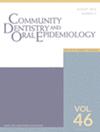Prevalence and social determinants of periodontal disease in Colombian pregnant women
Abstract
Objective
The objective of the study was to identify the prevalence of periodontal disease in pregnant women in the Colombian population and its association with social determinants and medical history based on data from the Fourth National Oral Health Survey (ENSAB IV).
Methods
A total of 1012 pregnant women from different areas of Colombia were evaluated. A periodontal evaluation was performed using a North Carolina periodontal probe. The following data were recorded: number of teeth, probing depth (PD), the position of the gingival margin (GM) and clinical attachment level (CAL). An ordinal logistic regression analysis was performed for the association between social determinants and the Centers for Disease Control and Prevention and the American Academy of Periodontology (CDC/AAP) classification and logistic regression between social determinants and the European Federation of Periodontology (EFP) classification.
Results
The prevalence of periodontitis was 37.1% using the CDC/AAP criteria and 41.2% according to the criteria of EFP distributed in sensitive (40.2%) and specific cases (0.9%). Age, belonging to a subsidized regime, living in a rural area, having an intermittent water supply and bleeding in medical records were found to be positively associated with periodontitis (mild, moderate, severe).
Conclusions
The findings of this national study of pregnant women show a high prevalence of periodontitis—using the CDC/AAP and EFP criteria—associated with age, living in rural areas, subsidized regime, intermittent water supply and bleeding in medical records.

 求助内容:
求助内容: 应助结果提醒方式:
应助结果提醒方式:


